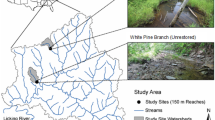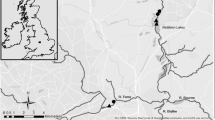Abstract
An assessment of the benthic macroinvertebrate community was conducted to characterize the ecological recovery of a channelized main stem and two small tributaries at the Watershed Research and Education Center (WREC, Arkansas, USA). Three other headwater streams in the same basin were also sampled as controls and for biological reference information. A principal components analysis produced stream groupings along an overall gradient of physical habitat integrity, with degraded reaches showing lower RBP habitat scores, reduced flow velocities, smaller substrate sizes, greater conductivity, and higher percentages of sand and silt substrate. The benthic macroinvertebrate assemblage at WREC was dominated by fast-reproducing dipteran larvae (midge and mosquito larvae) and physid snails, which comprised 71.3% of the total macroinvertebrate abundance over three sampling periods. Several macroinvertebrate assemblage metrics should provide effective targets for monitoring overall improvements in the invertebrate assemblage including recovery towards a more complex food web (e.g., total number of taxa, number of EPT taxa, percent 2 dominant taxa). However, current habitat conditions and the extent of existing degradation, system isolation and surrounding urban or agricultural land-uses might affect the level of positive change to the system. We therefore suggest a preliminary restoration strategy involving the addition of pool habitats in the system. At one pool we collected a total of 29 taxa (dominated by water beetle predators), which was 59% of total number of taxa collected at WREC. Maintaining water-retentive pools to collect flows and maintain water permanence focuses on enhancing known biology and habitat, thus reducing the effects of abiotic filters on macroinvertebrate assemblage recovery. Furthermore, biological assessment prior to restoration supports a strategy primarily focused on improving the existing macroinvertebrate community in the current context of the system, thereby reducing costs associated with active channel restoration. Monitoring future biological recovery and determining the contribution of changing assemblages to specific ecological processes would provide a critical underpinning for adaptive management and ecologically-effective restoration.







Similar content being viewed by others
References
Alexander RB, Boyer EW, Smith RA, Schwarz GE, Moore RB (2007) The role of headwater streams in downstream water quality. Journal of the American Water Resources Association 43(1):41–59
Barbour MT, Gerritsen J, Snyder BD, Stribling JB (1999) Rapid Bioassessment Protocols for Use in Wadeable Streams and Rivers: Periphyton, Benthic Macroinvertebrates and Fish. Second Edition. EPA 841-B-99–002. US Environmental Protection Agency, Office of Water, Washington, DC
Barker LS, Felton GK, Russek-Cohen E (2006) Use of Maryland biological stream survey data to determine effects of agricultural riparian buffers on measures of biological stream health. Environmental Monitoring and Assessment 117:1–19
Bender JH, Case TJ, Gilpin ME (1984) Perturbation experiments in community ecology: theory and practice. Ecology 65:1–13
Beschta RL, Platts WS (1986) Morphological features of small streams: significance and function. Water Resources Bulletin 22(3):369–379
Braccia A, Voshell JR Jr (2006) Benthic macroinvertebrate fauna in small streams used by cattle in the Blue Ridge Mountains, Virginia. Northeastern Naturalist 13(2):269–286
Bunte K, Abt SR (2001) Sampling surface and sub-surface particle size distributions in wadeable gravel- and cobble-bed streams for analyses in sediment transport, hydraulics, and streambed monitoring. Gen. Tech. Rep. RMRS-GTR-74. U.S. Department of Agriculture, Forest Service, Rocky Mountain Research Station, Fort Collins, CO
Camargo JA, Alonso A, De La Puente M (2004) Multimetric assessment of nutrient enrichment in impounded rivers based on benthic macroinvertebrates. Environmental Monitoring and Assessment 96:233–249
Cooper CM (1993) Biological effects of agriculturally derived surface water pollutants on aquatic systems–a review. Journal of Environmental Quality 22:402–408
Covich AP, Palmer MA, Crowl TA (1999) The role of benthic invertebrate species in freshwater ecosystems: Zoobenthic species influence energy flows and nutrient cycling. Bioscience 49:119–128
Daniels RB, Gilliam JW (1996) Sediment and chemical load reduction by grass and riparian filters. Soil Science Society of America 60:246–251
DeLaune PB, Haggard BE, Daniel TC, Chaubey I, Cochran MC (2006) The Eucha/Spavinaw phosphorus index: a court mandated index for litter management. Journal of Soil and Water Conservation 61:96–105
Dietz ME, Clausen JC, Filchak KK (2004) Education and changes in residential non-point source pollution. Environmental Management 34(5):684–690
Feest A (2006) Establishing baseline indices for the quality of the biodiversity of restored habitats using a standardized sampling process. Restoration Ecology 14(1):112–122
Frid CLJ, Clark S (1999) Restoring aquatic systems: an overview. Aquatic Conservation: Marine and Freshwater Ecosystems 9:1–4
Gore JA, Kelly JR, David Yount J (1990) Application of ecological theory to determining recovery potential of disturbed lotic ecosystems: research needs and priorities. Environmental Management 14(5):755–762
Haggard BE, Moore PA Jr, Chaubey I, Stanley EH (2003) Nitrogen and phosphorus concentrations and export in an Ozark plateaus catchment in the United States. Biosystems Engineering 86(1):75–85
Heatherly T II, Whiles MR (2007) Relationships between water quality, habitat quality, and macroinvertebrate assemblages in Illinois streams. Journal of Environmental Quality 36:1653–1660
Hilsenhoff WL (1987) An improved biotic index of organic stream pollution. Great Lakes Entomologist 20:31–39
Huryn AD, Wallace JB (2000) Life history and production of stream insects. Annual Review of Entomology 45:83–110
Karr JR (1987) Biological monitoring and environmental assessment: a conceptual framework. Environmental Management 11:249–256
Kelly JR, Harwell MA (1990) Indicators of ecosystem recovery. Environmental Management 14:527–545
Kremen C (2005) Managing ecosystem services: what do we need to know about their ecology? Ecology Letters 8:468–479
Kyriakeas SA, Watzin MC (2006) Effects of adjacent agricultural activities and watershed characteristics on stream macroinvertebrate communities. Journal of the American Water Resources Association 42:425–441
Lazorchak JM, Klemm DJ, Peck DV (1998) Environmental and monitoring program–surface waters: Field operations and methods for measuring the ecological condition of wadeable streams. EPA/620/R-94/004F. U.S. Environmental Protection Agency, National Exposure Research Laboratory, Cincinnati, OH
McCune B, Grace JB (2002) Analysis of Ecological Communities. MjM software design, Gleneden Beach, OR
McKinstry MC, Caffrey P, Henderson SH (2001) The importance of beaver to wetland habitats and waterfowl in Wyoming. Journal of the American Water Resources Association 37:1571–1577
Menninger HL, Palmer MA (2006) Restoring ecological communities: from theory to practice. In: Falk DA, Palmer MA, Zedler JB (eds) Foundations of restoration ecology. Island Press, Washington, pp 88–112
Merrit RW, Cummins K, Berg MB (2008) Aquatic Insects of North America. Kendall/Hunt publishers, Dubuque, Iowa
Moulton SR, Stewart KW (1996) Caddisflies (Trichoptera) of the Interior Highlands of North America. American Entomological Institute, Gainesville, Florida
Muenz TK, Golloday SW, Vellidis G, Smith LL (2006) Stream buffer effectiveness in an agriculturally influenced area, southwestern Georgia: responses of water quality, macroinvertebrates, and amphibians. Journal of Environmental Quality 35:1924–1938
Munn ML, Meyer JL (1990) Habitat-specific solute retention in two small streams: an intersite comparison. Ecology 71:2069–2082
Naeem S (1998) Species redundancy and ecosystem reliability. Conservation Biology 12:39–45
Nerbonne BA, Vondracek (2001) Effects of local land-use on physical habitat, benthic macroinvertebrates, and fish in the Whitewater River, Minnesota, USA. Environmental Management 28(1):87–99
Nislow KN, Lowe WH (2006) Influences of logging history and riparian forest characteristics on macroinvertebrates and brook trout (Salvelinus fontinalis) in headwater streams (New Hampshire, USA.). Freshwater Biology 51:388–397
Omernik JamesM (1987) Map supplement: ecoregions of the conterminous United States. Annals of the Association of American Geographers 77:118–125
Paul MJ, Meyer JL (2001) Streams in the urban landscape. Annual Review of Ecology and Systematics 32:333–365
Pfankuch DJ (1975) Stream reach inventory and channel stability evaluation: a watershed management procedure. U.S. Department of Agriculture Forest Service Northern Region. Missoula, Montana
Poff NL, Ward JV (1989) Implications of streamflow variability and predictability for lotic community structure: a regional analysis of streamflow patterns. Canadian Journal of Fisheries and Aquatic Sciences 46:1805–1818
Poulton BC, Stewart KW (1991) The stoneflies of the Ozark and Ouachita Mountains (Plecoptera). Memoirs of the American Entomological Society. Number 38, 116 pp
Resh VH, Jackson JK (1993) Rapid assessment approaches to biomonitoring using benthic macroinvertebrates. In: Resh VH, Rosenberg DM (eds) Freshwater biomonitoring and benthic macroinvertebrates. Chapman and Hall, London
Rosenfeld JS (2002) Functional redundancy in ecology and conservation. Oikos 98:156–162
Roy AH, Rosemond AD, Paul MJ, Leigh DS, Wallace JB (2003) Stream macroinvertebrate response to catchment urbanization (Georgia. U.S.A.). Freshwater Biology 48:329–346
Schoonover JE, Williard KWJ, Zaczek JJ, Mangun JC, Carver AD (2005) Nutrient attenuation in agricultural surface runoff by riparian buffer zones in southern Illinois, USA. Agroforestry Systems 64(2):169–180
Shields FD Jr, Copeland RR, Klingeman PC, Doyle MW, Simon A (2003) Design for stream restoration. Journal of Hydraulic Engineering 129(8):575–584
Shields FD Jr, Knight SS, Cooper CM (2007) Can warmwater streams be rehabilitated using watershed-scale standard erosion control measures alone? Envrionmental Management 40:62–97
Society for Ecological Restoration International Science and Policy Working Group (2004) The SER international primer on ecological restoration. www.ser.org and Society for Ecological Restoration International, Tucson
Sponseller RA, Benfield EF, Valett HM (2001) Relationships between land-use, spatial scale, and stream macroinvertebrate communities. Freshwater Biology 46:1409–1424
Statzner B, Gore JA, Resh VH (1988) Hydraulic stream ecology: observed patterns and potential applications. Journal of the North American Benthological Society 7:307–360
Sudig KN, Gross KL (2006) The dynamic nature of ecological systems: multiple states and restoration trajectories. In: Falk DA, Palmer MA, Zedler JB (eds) Foundations of restoration ecology. Island Press, Washington, pp 190–209
Urban DL (2006) A modelling framework for restoration ecology. In: Falk DA, Palmer MA, Zedler JB (eds) Foundations of restoration ecology. Island Press, Washington, pp 238–256
USEPA (2000) Principles for the Ecological Restoration of Aquatic Resources. EPA841-F-00–003. U.S. Environmental Protection Agency, Office of Water, Washington, DC
Vander Zanden MJ, Olden JD, Gratton C (2006) Food-web approached in restoration ecology Pages 165–189. In: Falk DA, Palmer MA, Zedler JB (eds) Foundations of Restoration Ecology. Island Press,
Vannote RI, MInshall GW, Cummings KW, Sedell JR, Cushing CE (1980) The river continuum concept. Canadian Journal of Fisheries and Aquatic Sciences 37:120–137
Voshell JR, Jr, Layton RJ, Hiner SW (1989) Field techniques for determining the effects of toxic substances on benthic macroinvertebrates in rocky-bottomed streams. In: Cowgill UM, Williams LR Aquatic toxicology and hazard assessment, vol 12, eds. American Society for Testing and Materials Special Technical Publication 1027. American Society for Testing and Materials, Philadelphia, PA, pp 134–155
Wallace JB, Webster JR (1996) The role of macroinvertebrates in stream ecosystem function. Annual Review of Entomology 41:115–139
Waters TF (1995) Sediment in streams: sources, biological effects, and control. In: Monograph 7. American Fisheries Society, Bethesda
Watzin MC, McIntosh AW (1999) Aquatic ecosystems in agricultural landscapes: a review of ecological indicators and achievable ecological outcomes. Journal of Soil and Water Conservation 4:636–644
Wright JP, Jones CG, Flecker AS (2002) An ecosystem engineer, the beaver, increases species richness at the landscape level. Oecologia 132:96–101
Zedler JB (2000) Progress in wetland restoration ecology. Trends in Ecology and Evolution 15:402–407
Acknowledgments
We thank Geneva Brion and Stephanie Williamson for water quality sampling and analysis. We are very grateful to the Daly, Rush, Huffmaster, and Centers families for allowing access to their streams. Funding for this study was provided by the Arkansas Agricultural Experiment Station, University of Arkansas, Division of Agriculture. The comments of reviewers were much appreciated and greatly improved the original manuscript.
Author information
Authors and Affiliations
Corresponding author
Rights and permissions
About this article
Cite this article
Longing, S.D., Haggard, B.E. Biological Assessment to Support Ecological Recovery of a Degraded Headwater System. Environmental Management 46, 459–470 (2010). https://doi.org/10.1007/s00267-010-9532-0
Received:
Accepted:
Published:
Issue Date:
DOI: https://doi.org/10.1007/s00267-010-9532-0




